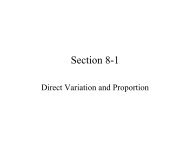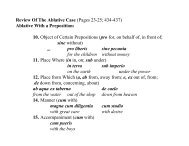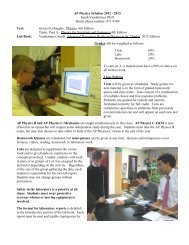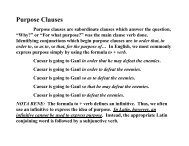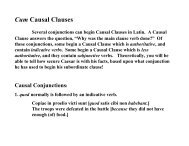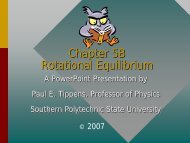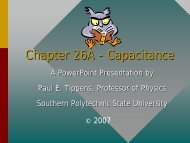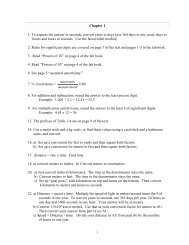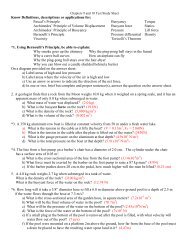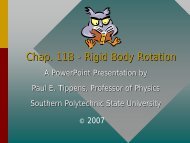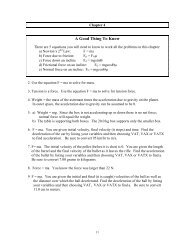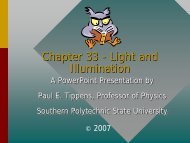Chapter 4B. Friction and Equilibrium
Chapter 4B. Friction and Equilibrium
Chapter 4B. Friction and Equilibrium
Create successful ePaper yourself
Turn your PDF publications into a flip-book with our unique Google optimized e-Paper software.
<strong>Chapter</strong> <strong>4B</strong>. <strong>Friction</strong> <strong>and</strong><br />
<strong>Equilibrium</strong><br />
A PowerPoint Presentation by<br />
Paul E. Tippens, Professor of Physics<br />
Southern Polytechnic State University<br />
© 2007
<strong>Equilibrium</strong>: Until motion<br />
begins, all forces on the mower<br />
are balanced. <strong>Friction</strong> in wheel<br />
bearings <strong>and</strong> on the ground<br />
oppose the lateral motion.
Objectives: After completing this<br />
module, you should be able to:<br />
• Define <strong>and</strong> calculate the coefficients of<br />
kinetic <strong>and</strong> static friction, <strong>and</strong> give the<br />
relationship of friction to the normal force.<br />
• Apply the concepts of static <strong>and</strong> kinetic<br />
friction to problems involving constant<br />
motion or impending motion.
<strong>Friction</strong> Forces<br />
When two surfaces are in contact, friction forces<br />
oppose relative motion or impending motion.<br />
P<br />
<strong>Friction</strong> forces are parallel to<br />
the surfaces in contact <strong>and</strong><br />
oppose motion or impending<br />
motion.<br />
Static <strong>Friction</strong>: No<br />
relative motion.<br />
Kinetic <strong>Friction</strong>:<br />
Relative motion.
<strong>Friction</strong> <strong>and</strong> the Normal Force<br />
4 N<br />
n<br />
2 N<br />
8 N<br />
n<br />
4 N<br />
12 N<br />
n<br />
6 N<br />
The force required to overcome static or kinetic<br />
friction is proportional to the normal force, n.<br />
ff s s<br />
= n s s<br />
ff k k<br />
= n k k
<strong>Friction</strong> forces are independent of area.<br />
4 N 4 N<br />
If the total mass pulled is constant, the same<br />
force (4 N) is required to overcome friction<br />
even with twice the area of contact.<br />
For this to be true, it is essential that ALL<br />
other variables be rigidly controlled.
<strong>Friction</strong> forces are independent of<br />
temperature, provided no chemical or<br />
structural variations occur.<br />
4 N 4 N<br />
Heat can sometimes cause surfaces to become<br />
deformed or sticky. In such cases, temperature<br />
can be a factor.
<strong>Friction</strong> forces are independent of speed.<br />
5 m/s 20 m/s<br />
2 N<br />
2 N<br />
The force of kinetic friction is the same at<br />
5 m/s as it is for 20 m/s. . Again, we must<br />
assume that there are no chemical or<br />
mechanical changes due to speed.
The Static <strong>Friction</strong> Force<br />
When an attempt is made to move an<br />
object on a surface, static friction slowly<br />
increases to a MAXIMUM value.<br />
f s<br />
n<br />
W<br />
P<br />
In this module, when we use the following<br />
equation, we refer only to the maximum<br />
value of static friction <strong>and</strong> simply write:<br />
f<br />
s<br />
<br />
s<br />
n<br />
ff s s<br />
= n s s
Constant or Impending Motion<br />
For motion that is impending <strong>and</strong> for<br />
motion at constant speed, the resultant<br />
force is zero <strong>and</strong> F F = 0. (<strong>Equilibrium</strong>)<br />
Constant Speed<br />
P<br />
P<br />
f s<br />
Rest<br />
P – f s = 0<br />
f k<br />
P – f k = 0<br />
Here the weight <strong>and</strong> normal forces are<br />
balanced <strong>and</strong> do not affect motion.
<strong>Friction</strong> <strong>and</strong> Acceleration<br />
When P is greater than the maximum f s<br />
the resultant force produces acceleration.<br />
a<br />
f k P<br />
Constant Speed<br />
This case will be<br />
discussed in a<br />
later chapter.<br />
f k = n k<br />
Note that the kinetic friction force remains<br />
constant even as the velocity increases.
EXAMPLE 1: If k = 0.3 <strong>and</strong> s = 0.5,<br />
what horizontal pull P is required to<br />
just start a 250-N block moving?<br />
f s<br />
n<br />
W<br />
P<br />
+<br />
1. Draw sketch <strong>and</strong> free-<br />
body diagram as shown.<br />
2. List givens <strong>and</strong> label<br />
what is to be found:<br />
k = 0.3; s = 0.5; W = 250 N<br />
Find: P = ? to just start<br />
3. Recognize for impending motion: P – f s = 0
EXAMPLE 1(Cont.): s = 0.5, W = 250 N. Find<br />
P to overcome f s (max). . Static friction applies.<br />
f s<br />
n<br />
P<br />
+<br />
For this case: P – f s = 0<br />
4. To find P we need to<br />
know f s , which is:<br />
250 N<br />
f s = n n = ?<br />
s<br />
5. To find n:<br />
F y = 0 n – W = 0<br />
W = 250 N<br />
250 N n = 250 N<br />
(Continued)
EXAMPLE 1(Cont.): s = 0.5, W = 250 N. Find P<br />
to overcome f s (max). . Now we know n = 250 N. N<br />
6. Next we find f s from:<br />
f s = n s = 0.5 (250 N)<br />
7. For this case: P – f s = 0<br />
P = f s = 0.5 (250 N)<br />
P = 125 N<br />
f s<br />
n<br />
250 N<br />
P<br />
s = 0.5<br />
+<br />
This force (125(<br />
N) is needed to just start motion.<br />
Next we consider P needed for constant speed.
EXAMPLE 1(Cont.): If k = 0.3 <strong>and</strong> s = 0.5,<br />
what horizontal pull P is required to move with<br />
constant speed? ? (Overcoming kinetic friction)<br />
F y = mam<br />
y = 0<br />
k = 0.3<br />
f k<br />
mg<br />
n<br />
P<br />
+<br />
n - W = 0<br />
n = W<br />
Now: f k = n k = k W<br />
F x = 0; P - f k = 0<br />
P = f k = k W<br />
P = (0.3)(250 N) P = 75.0 N
The Normal Force <strong>and</strong> Weight<br />
The normal force is NOT always equal to<br />
the weight. The following are examples:<br />
W<br />
n<br />
m<br />
P<br />
30 0<br />
Here the normal force is<br />
less than weight due to<br />
upward component of P.<br />
n<br />
<br />
W<br />
P<br />
Here the normal force is<br />
equal to only the component<br />
of weight perpendicular<br />
to the plane.
Review of Free-body Diagrams:<br />
For <strong>Friction</strong> Problems:<br />
• Read problem; draw <strong>and</strong> label sketch.<br />
• Construct force diagram for each object,<br />
vectors at origin of x,y axes. Choose x or y<br />
axis along motion or impending motion.<br />
• Dot in in rectangles <strong>and</strong> label x <strong>and</strong> y compo-<br />
nents opposite <strong>and</strong> adjacent to angles.<br />
• Label all components; choose positive<br />
direction.
For <strong>Friction</strong> in <strong>Equilibrium</strong>:<br />
• Read, draw <strong>and</strong> label problem.<br />
• Draw free-body diagram for for each body.<br />
• Choose x or or y-axis y<br />
along motion or or impending<br />
motion <strong>and</strong> choose direction of of motion as as positive.<br />
• Identify the normal force <strong>and</strong> write one of<br />
of<br />
following:<br />
f s = s n or f k = k n<br />
f s = s n or f k = k n<br />
• For equilibrium, we write for for each axis:<br />
F F x = x 0 F F y = y 0<br />
• Solve for for unknown quantities.
Example 2. A force of 60 N drags a 300-N<br />
block by a rope at an angle of 40 0 above the<br />
horizontal surface. If u k = 0.2, what force P<br />
will produce constant speed?<br />
W = 300 N<br />
n<br />
f k<br />
m<br />
W<br />
P = ?<br />
40 0<br />
The force P is to be<br />
replaced by its com-<br />
ponents P x <strong>and</strong> P y .<br />
1. Draw <strong>and</strong> label a sketch<br />
of the problem.<br />
2. Draw free-body diagram.<br />
P sin 40 0<br />
n<br />
P y<br />
40 0 P<br />
P x<br />
P y<br />
f k P cos 40 0<br />
W +
Example 2 (Cont.). P = ?; W = 300 N; u k = 0.2.<br />
3. Find components of P:<br />
P x = P cos 40 0 = 0.766P<br />
P y = P sin 40 0 = 0.643P<br />
P x = 0.766P; P y = 0.643P<br />
P sin 40 0<br />
n<br />
40 0 P<br />
f k<br />
mg +<br />
P cos 40 0<br />
Note: Vertical forces are balanced, <strong>and</strong> for<br />
constant speed, horizontal forces are balanced.<br />
Fx<br />
0 Fy<br />
0
Example 2 (Cont.). P = ?; W = 300 N; u k = 0.2.<br />
P x = 0.766P<br />
P y = 0.643P<br />
4. Apply <strong>Equilibrium</strong> con-<br />
ditions to vertical axis.<br />
F y y<br />
= 0<br />
0.643P<br />
n<br />
300 N<br />
40 0 P<br />
f k<br />
+<br />
0.766P<br />
n + 0.643P – 300 N N= 0 [P y <strong>and</strong> n are up (+)](<br />
n = 300 N – 0.643P;<br />
Solve for n in terms of P<br />
n = 300 N – 0.643P
Example 2 (Cont.). P = ?; W = 300 N; u k = 0.2.<br />
n = 300 N – 0.643P<br />
5. Apply F x = 0 to con-<br />
stant horizontal motion.<br />
F x x<br />
= 0.766P – ff k k<br />
= 0<br />
0.643P<br />
n<br />
300 N<br />
40 0 P<br />
f k<br />
+<br />
0.766P<br />
f k = n k = (0.2)(300 N - 0.643P)<br />
f k = (0.2)(300 N - 0.643P) ) = 60 N – 0.129P<br />
0.766P – f k = 0;<br />
0.766P – (60 N – 0.129P) = 0
Example 2 (Cont.). P = ?; W = 300 N; u k = 0.2.<br />
0.643P<br />
n<br />
300 N<br />
40 0 P<br />
f k 0.766P<br />
+<br />
0.766P – (60 N – 0.129P )=0<br />
6. Solve for unknown P.<br />
0.766P – 60 N + 0.129P =0<br />
0.766P + 0.129P = 60 N If P = 67 N, the<br />
block will be<br />
0.766P + 0.129P = 60 N dragged at a<br />
0.895P = 60 N<br />
constant speed.<br />
P = 67.0 N<br />
P = 67.0 N
Example 3: What push P up the incline is<br />
needed to move a 230-N block up the<br />
incline at constant speed if k = 0.3?<br />
P<br />
Step 1: Draw free-body<br />
including forces, angles<br />
<strong>and</strong> components.<br />
y<br />
W sin 60 0<br />
f k<br />
n<br />
P<br />
60 0<br />
x<br />
W cos 60 0<br />
60 0<br />
W =230 N<br />
Step 2: F y = 0<br />
n –W cos 60 0 = 0<br />
n = (230 N) cos 60 0<br />
230 N<br />
n = 115 N
Example 3 (Cont.): Find<br />
Find P to give<br />
move up the incline (W = 230 N).<br />
60 0<br />
y n x<br />
P n = 115 N W = 230 N<br />
f Step 3. Apply F x = 0<br />
k W cos 60 0<br />
W sin 60 0 60 0 P - f k - W sin 60 0 = 0<br />
W<br />
f k = n k = 0.2(115 N)<br />
f k = 23 N, P = ?<br />
P - 23 N - (230 N)sin 60 0 = 0<br />
P - 23 N - 199 N N= 0 P = 222 N
Summary: Important Points to Consider<br />
When Solving <strong>Friction</strong> Problems.<br />
• The maximum force of static friction is<br />
the force required to just start motion.<br />
f s<br />
n<br />
W<br />
P<br />
f<br />
s<br />
<br />
s<br />
n<br />
<strong>Equilibrium</strong> exists at that instant:<br />
F<br />
0; F<br />
0<br />
x<br />
y
Summary: Important Points (Cont.)<br />
• The force of kinetic friction is that force<br />
required to maintain constant motion.<br />
f k<br />
n<br />
W<br />
P<br />
f<br />
k<br />
<br />
k<br />
n<br />
• <strong>Equilibrium</strong> exists if speed is constant,<br />
but f k does not get larger as the<br />
speed is increased.<br />
F<br />
0; F<br />
0<br />
x<br />
y
Summary: Important Points (Cont.)<br />
• Choose an x or y-axis along the direction<br />
of motion or impending motion.<br />
k = 0.3<br />
f k<br />
W<br />
n<br />
P<br />
+<br />
The F will be zero<br />
along the x-axis<br />
<strong>and</strong><br />
along the y-axis.<br />
In this figure, we have:<br />
F<br />
0; F<br />
0<br />
x<br />
y
Summary: Important Points (Cont.)<br />
• Remember the normal force n is not<br />
always equal to the weight of an object.<br />
P<br />
n It is necessary to draw<br />
30 0<br />
m the free-body diagram<br />
W<br />
<strong>and</strong> sum forces to solve<br />
for the correct n<br />
P<br />
value.<br />
n<br />
<br />
F<br />
0; F<br />
0<br />
W x<br />
y
Summary<br />
Static <strong>Friction</strong>: No<br />
relative motion.<br />
ff ss ≤ n s s<br />
Kinetic <strong>Friction</strong>:<br />
Relative motion.<br />
ff k k<br />
= n k k<br />
Procedure for solution of equilibrium<br />
problems is the same for each case:<br />
F<br />
0 F<br />
0<br />
x<br />
y
CONCLUSION: <strong>Chapter</strong> <strong>4B</strong><br />
<strong>Friction</strong> <strong>and</strong> <strong>Equilibrium</strong>




